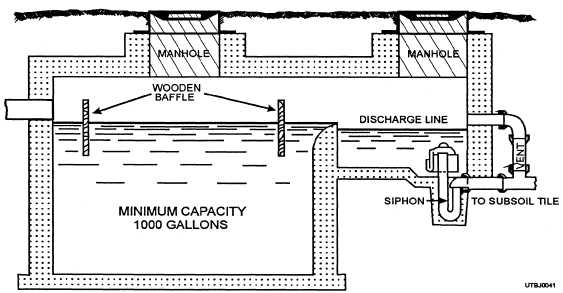added, and the downward rate of percolation is measured in minutes required for the water surface to lower 1 inch in the hole.
Septic Tanks
For emergency and temporary construction, septic tanks are made of wood or nonreinforced concrete with wood covers and baffles. Reinforced concrete construction is more suitable for permanent installations (fig. 2-13). The tank capacity should equal a full day's floss, plus an allowance of from 15 to 25 percent for sludge capacity. The minimum size of a tank required by code is 1,000 gallons.
In constructing a septic tank, be sure the length of the septic tank is not less than two, or more than three times the width. The liquid depth should not be less than 4 feet for the smaller tanks and 6 feet for the larger ones. Manholes should be provided over the inlet and outlet pipes and over the low points in the bottom of hopper bottom tanks. The roof of the tank may be covered with earth, but access openings should extend at least to the ground surface. Although ells or tees may be used at inlet and outlet connections, straight connections are better for rodding (cleaning out). Instead of ells, wooden baffles, located approximately 18 inches from the ends of the tank and extending 18 inches below and 12 inches above the flow line, are provided. Elevations should permit free flow into and out of the tank. The bottom of the inlet sewer should be at least 3 inches above the water level in the tank. The inlet and outlet connections should be sufficiently buried or otherwise protected to prevent damage by traffic or frost.
Although septic tanks that are designed properly require little operating attention, they must be inspected periodically; the frequency of inspection is determined by the size of the tank and the population load. The minimum frequency should be once every 2 months at periods of high flow. The inspection should be made to assure that the inlet and outlet are free from clogging, the depth of scum and sludge accumulationis not excessive, and the effluent passing to subsurface disposal is relatively free of suspended solids. A high concentration of suspended solids in the effluent clogs subsurface disposal facilities quickly. Sludge and scum accumulation should not exceed one fourth of the tank capacity. It should not be assumed septic tanks liquefy all solids, they never need cleaning, and the effluent is pure and free of germs. Perhaps 40 to 60 percent of the suspended solids is retained, and the rest is discharged in the effluent.
Separating sludge and scum from the liquid in septic tanks is difficult. In small tanks, these wastes are customarily mixed; the entire contents are removed when the tanks are cleaned. The material removed contains fresh or partially digested sewage solids that must be disposed of without endangering the health of personnel. Disposal through manholes in the nearest sewer system, as approved by local authorities, or burial in shallow furrows on open land is

Figure 2-13. - Septic tank.
Continue Reading